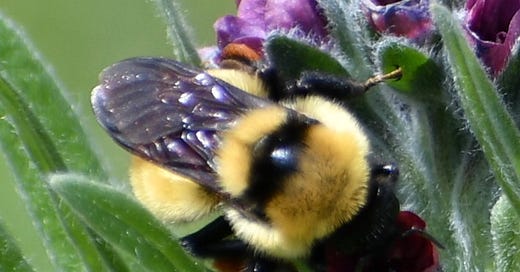Don't Mow, Let It Grow: May is the Month to Help Pollinators Thrive by Watching the Grass Grow
No Mow May can provide time to focus on noxious weeds
By Denise Rivette
The news of honeybee declines and butterflies also in decline is bleak, but you can help pollinator populations rebound by doing nothing. That’s right, by not mowing your yard during the month of May, you can provide much needed food to help these beneficial insects thrive.
Started in 2019 by the British botanical charity Plantlife, No Mow May is a conservation campaign that encourages people to not mow their lawn during the month of May in order to let wild flowers bloom and provide a nectar feast for pollinators such as bees and butterflies. Bee City USA soon jumped on board and started promoting the program in the United States. The concept is simple and doesn’t require the entire lawn remain unmowed. In fact many people use a mowed strip of lawn around the edge of their yard to delineate their natural preserve/wildflower garden and found that it satisfied their local ordinances.
A lush, green, weed-free lawn consisting of a single grass species has long been the iconic American display of hardworking competence and societal respect. While “dandelions and an overgrown lawn are a sign of neglect, incompetence and laziness – or so our culture would have you believe,” states the Bee City USA website.
They further state that Americans’ love affair with lawns includes maintaining roughly 40 million acres of grass. This makes lawns the single largest irrigated crop in the United States. A crop that not only does not sustain human life or improve the environment, but takes up 2% of the land in the U.S. and does not even benefit wildlife when mowed weekly. When we think of habitat loss, we tend to think of paved over land, states a Bee City USA representative, “but acres of manicured lawn are as much a loss of habitat as any development site.”
The Appleton Bee City USA affiliate group, Pollenablers-Fox Cities, and the Bee Campus USA affiliate group, Appleton Pollinator Project, teamed up in 2020 to launch the United States’ first No Mow May initiative. The basic tenet of the program is that the voluntary delay of early lawn mowing for the month of May increases spring pollinator habitat and foraging opportunities as early flowering grasses and sedges are allowed time to blossom and provide an essential boost of energy for pollinating insects.
Knowing how deeply ingrained the notion of manicuring a perfect lawn is in the American psyche the sponsoring groups, as well as Appleton city staff, anticipated far more resistance and pushback from the community. In the beginning, there were fears that the program would increase animosity and conflict among neighbors, that it would lead to explosions of rodents and ticks in tall grasses, and that it would destroy lawn mowers as they moved through knee high grass. Not only did those things not come to pass, but to everyone’s surprise, weed complaints rose only negligibly and a large portion of the community participated in the program.
Even more surprising was the impact of the program in its first year recorded in the data collected by community scientists. They found that no-mow lawns had five times the number of bees and three times the bee species than comparable mowed areas. Their sampling in 2021 also showed an increase in overall insect diversity and abundances in unmowed areas. This has potential upstream effects for pollination and sustaining other animal biodiversity in urban and suburban spaces.
Other studies have looked into how reducing the frequency of mowing impacts bees. The USDA Forest Service study, conducted by research ecologist Susannah Lerman, found that mowing every other week increased bee abundance. It also found that mowing every three weeks more than doubled the flowers available and increased bee diversity, however it lowered overall bee abundance versus the every other week strategy, possibly because taller grass made it harder to get to the flowers. It has been shown in other studies that the benefits of reducing mowing can be enhanced by altering the composition of the lawn. A “bee lawn” may include clover (which captures nitrogen and helps feed the lawn) as well as other low-growing flowering plants such as creeping thyme (Thymus spp.), self-heal (Prunella vulgaris), and other beneficial herbs. In addition to benefiting pollinators, reducing mowing frequency will save water, help your lawn become more resilient to drought, and reduce emissions from gas-powered lawn equipment.
There are other tasks you can perform to benefit your yard and the environment this month. For instance, pulling noxious weeds is easier when the ground is still moist from snowmelt. According to the Carbon County Weed District, “Noxious weeds are non-native plants that have been introduced to Carbon County through human actions both purposely and by accident. Due to their aggressive growth and lack of natural enemies, these species can be highly destructive, competitive, or difficult to control. It is important to remember that noxious weeds are everyone’s problem. They not only reduce crop yields, destroy native plant communities, and degrade wildlife habitat, they can also damage recreational sites, clog waterways, lower land values, and poison livestock. The Carbon County Weed District can assist you with identifying noxious weeds and give you advice on their control.”
Carbon County Weed District focuses on their education and assistance roles (for example, they rent herbicide application equipment), but they also provide enforcement. Noxious weeds are the responsibility of landowners to control and landowners can be cited for not controlling them. For more information on noxious weeds, you can call the Carbon County Weed District at (406) 962-3967.





Gardens not lawns. There are also biological methods (non-pesticide) for controlling noxious weeds.